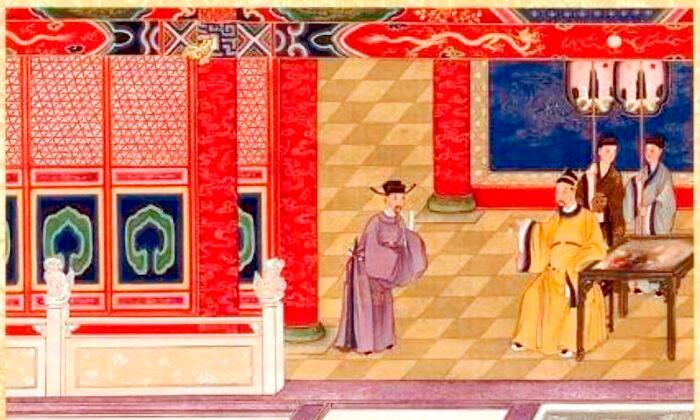It will be Thanksgiving Day in Canada, but at a U.S. military memorial service in New York State on October 8, the people of two Canadian towns will not only be giving thanks but will receive thanks.
The ceremony will mark the 65th anniversary of a great WWII American naval tragedy that occurred off the coast of Newfoundland and Labrador. Two American warships were destroyed, and 203 sailors perished.
But this is also a story about a heroic rescue by the people of two nearby towns, St. Lawrence and Lawn, that saved the lives of 186 men—a tale of courage, compassion, and enduring friendships.
On February 18, 1942, two American destroyers and the supply ship they were escorting to the U.S. Naval Base at Argentia, Newfoundland, ran aground due to a navigational error along the rugged shoreline on the southeastern coast of the Burin Peninsula.
It was bitterly cold, and a treacherous winter snowstorm was raging. Gale-force winds and huge, violent waves battered the ships. Thick, heavy crude oil leaked from the ships’ tanks and lay on top of the frigid water. The fl agship, U.S.S. Wilkes, managed to free itself. Sadly, those on the destroyer U.S.S. Truxtun and the supply ship U.S.S. Pollux were less fortunate.
Both ships ran aground close to shore, but the blizzard conditions made escape and rescue near impossible. Those who managed to reach the shore by swimming or life raft were faced with sheer, ice-covered cliffs rising as high as 300 feet.
The residents of Lawn and St. Lawrence gave assistance by tying a rope around the sailors one at a time and hauling them up the cliffs.
They then took the survivors, who were covered in oil, into their homes in nearby St. Lawrence. The women washed the sailors and provided them with clothing, meals, and shelter until the U.S. Navy was able to transport them to Argentia.
‘Strength of Humanity’
While the October 8 ceremony at the Long Island National Cemetery (LINC) in Farmingdale, New York will be the first official U.S. military service honouring the victims of the tragedy, every year there is a commemoration service in St. Lawrence and Lawn.
Mayor Wayde Rowsell of St. Lawrence will lay a wreath at the service at LINC, where there is a group burial site of the victims, including 66 whose names are unknown. He will also attend a service the next day at the East Coast War Memorial at Battery Park, New York. The names of all the sailors lost in the two shipwrecks are listed there.
“It’s a solemn occasion when you consider the sacrifice they made for humanity,” said Rowsell. “We remember with perpetual honour these men, and we pay homage to all those who lost their lives defending liberty and justice.”
While Rowsell calls his trip to the U.S. a “pilgrimage of honour,” the survivors and their relatives in return speak with gratitude about the valiant bravery and humanitarian hospitality of the people of St. Lawrence and Lawn.
“The whole warmth and care that they took for us was so strong that you couldn’t help but feel the strength of humanity,” said survivor Henry Strauss. “It was so dangerous for them. It was as if the whole town had no thoughts for themselves but only what they were doing for us…They even put clothes on us that they took off from their own clothing, because some of us had bare feet and some had no real clothes on at all.”
Strauss remembers thinking that the people who worked for hours pulling the sailors up the sheer cliffs must have been “giants” or “supermen.” Years later, however, when he returned to Newfoundland and met Jimmy Drake, one of the rescuers, who in 1942 was a boy of only about 17, “it was a kind of a shock. I’m only 5 foot 6, and he was about 2 inches shorter than I was.”
Levi Pike, another rescuer, was also only a teenager, like many of the sailors. It made a serious impression on him when he fi rst saw the Truxtun. Only about 20 men were left hanging onto the ship, and one or two more would be swept away each time a large wave came. Some died in the oil trying to swim to shore. “It was terrible,” said Pike.
Strauss received a Navy Commendation Medal for his efforts to establish a lifeline from the Pollux to land. In fact, many of the sailors participated in the rescue despite suffering from hypothermia and frostbite themselves.
‘Life-changing experience’
The “miracle of being saved” affected Strauss the rest of his life. After the war he started making films designed to make supervision in industry and corporations more sensitive to human relations.
Speaking about the huge navigational error made on the Wilkes, the flagship responsible for laying the course, Strauss noted the dilemma facing the Pollux’s commander when his navigator realized that the ship was off course and urged him to change course.
“You have to be absolutely certain that you’re right when you disobey an order and go on your own, which is what we should have done, but there was not that certainty because there had been such a storm, so our captain was torn between listening to the navigator who was going basically by experience not by fact, and ignoring the commanding offi cer whose ship has radar and all the rest.”
Lanier Phillips, the only African American survivor of the Truxtun, described his rescue and kind treatment by the Newfoundlanders as a “life-changing experience.” Born in 1923 in Georgia, Phillips grew up in the shadow of bigotry, racism, and the Ku Klux Klan.
He said one of the main reasons three other African American sailors stayed on board the Truxtun and perished was that they thought it was Iceland, where no blacks were allowed at the time, and were afraid they would be lynched if they went ashore.
Two years later in Jacksonville, Florida, when a policeman shoved him to the ground and threatened to shoot him because he was black—despite the fact that he was wearing his American serviceman’s uniform, he recalled the rescue.
“I couldn’t help but think of the people of St. Lawrence,” said Phillips, adding that his Newfoundland experience was the first time in his life he was treated as an equal.
His Newfoundland experience made him realize he should no longer accept inhumane treatment, and that he could work toward change. He later marched with Martin Luther King, Jr. and became active in the civil rights movement.
Their Greatness Not Forgotten
The wreck sites of the Truxtun and Pollux are a designated municipal historic site of Canada, said Rowsell, and many Americans come to visit, including the survivors’ children and grandchildren.
Gerard Bulanowski and his wife Judi are two such visitors. Bulanowski’s father, Walter, was one of the survivors on the Pollux. Walter later married and had seven children. “If it wasn’t for the people of Newfoundland and how they sacrifi ced their own lives to help save the lives of the men on the ship, we would not be here,” said Stan, the youngest son.
“They’ve kept alive the memories that the people here in the U.S. don’t have,” said Judi. Daughter Judith noted that those whose graves were marked unknown at LINC died without being recognized for what they did for their country. In fact, the family says, the survivors were generally treated as if they had done something wrong, because it was an accident as opposed to a combat manoeuvre.
These are the reasons the Bulanowski children were instrumental in arranging for the memorial services this year; they wanted to fi nally ensure due honour for these men. “This is our effort to recognize the entire tragedy and all the contributions,” Gerard said.
As for Strauss, 92, “I am still sailing,” he says. “You can see why I feel so strongly about St. Lawrence and Lawn, because they’ve given me a lot of years.”
In wartime, he added, “your whole consciousness and morals are adjusted so that you are able to kill people. What came through so strongly in this was the good that’s in people.”
Recognizing both the rescuers and sailors, Mayor Rowsell said, “It’s very important that their greatness be remembered.”




Friends Read Free